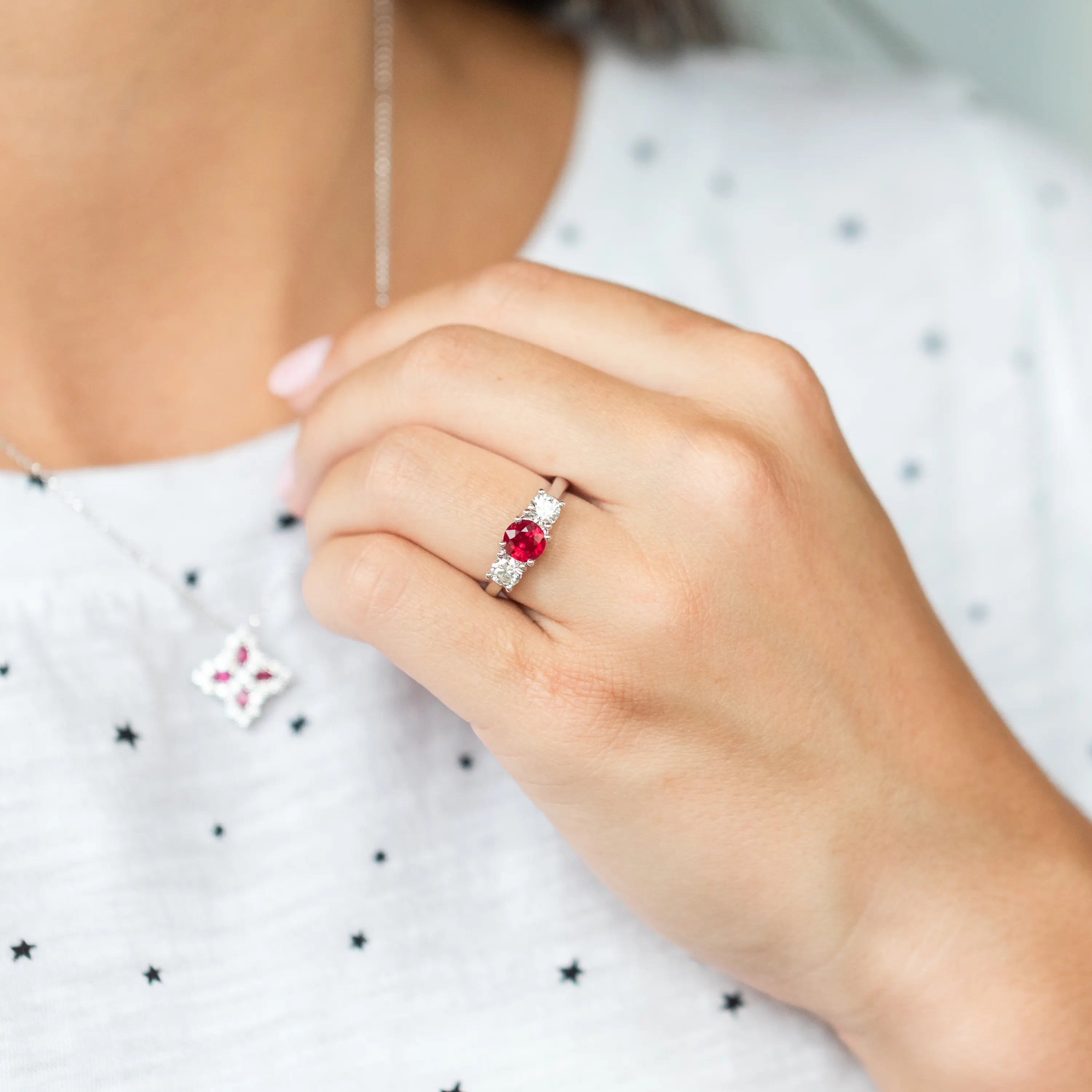
There are some people who are inherently luckier than others. If you doubt that statement at all, just consider that anyone born in the month of July calls Ruby their birthstone. Ruby, known as the king of precious gemstones, is the most valuable variety of the corundum mineral species, which also includes sapphires. Throughout history, cultures around the globe have favored rubies for their color, appeal, and value, making this July birthstone truly remarkable.

Cultures throughout history have favored rubies as valuable and powerful gemstones. Believed to represent life force, the redness of the ruby was correlated to red blood which flows through the veins and was thought to hold the power of life. The mystical beliefs around rubies are cross-cultural, making this gemstone a truly global favorite. Ancient Hindus believed that offering rubies to the god Krishna would grant them rebirth as an emperor, while people in India believed that rubies allowed those who possessed them to live in peace with their enemies. Warriors in ancient Burma believed they would be invincible in battles if they inserted rubies into their flesh. The protection of the stone would make them impervious to spear, sword, and gun wounds. Other historical sources claimed that rubies would increase the body's warmth and could help stop bleeding and inflammation. Rubies are named for the Latin word, ruber, which means red, and are mentioned four times in the bible, always in association with beauty and wisdom. Is is this historical context of beauty and wisdom which led rubies to become sought after throughout the western world, revealing themselves as a favorite gemstone amongst European royalty and upper classes. Many holders of ruby gemstones believed they possessed a unique inner fire. It was told that a ruby placed in water would bring the water to a boil and that wrapping a ruby to hide it was fruitless as the gem could shine though any covering to reveal its true presence. Medieval Europeans wore rubies to guarantee their health, wisdom, and success in love. Rubies became symbols of passion, wealth, and success due to westerner's affinity for the stones. According to legends, rubies protective powers help the wearer to control evil thoughts, dispel anger, and resolve disputes. It is no wonder then, that rubies have held high esteem throughout history as important gemstones. With a rich cultural heritage, it is important to understand where rubies come from, and how they are evaluated.
Historically, rubies were considered to be found in India. While this may have been true during historic periods, today rubies are found around the globe. The highest quality of rubies, however, are typically from Burma. Possessing the best color of the unique stone, these rubies can hold equal or greater value to diamonds. Today, Thailand is the main source of rubies globally. these stones tend to be darker in color with a red so deep they are almost violet. Thailand may be the largest producer, but rubies still come from India, with stones also found in Tanzania, Madagascar, Russia, Sri Lanka, Cambodia, Kenya, Mexico, Afghanistan, Pakistan, and North Carolina in the United States. Rubies are found in marble and basalt rocks, ranging in color from orangey-red to a darker purplish red. The color of a ruby is based on the Chromium trace in the element, without which the mineral would be colorless. This unique color and Chromium composition mean that rubies have the highest per-carat price of any colored stone in the world. Like many other stones. there are a few key components which determine the quality and value of a ruby.

The value of a ruby gemstone is most impacted by the color of the stone. Fine rubies are a pure, vibrant red to a slightly purplish red. These are the most expensive stones. The most valuable and rare of all rubies is the star ruby. It is a deep pure red color stone with a hint of purple, making it extremely sought-after shade. Star rubies tend to be found in smaller carat weights, typically below three carats. A perfect star ruby is extremely rare, and most star rubies are cut into oval gemstones to highlight their unique color. As with other gemstones, color is only one aspect of the value of the stone. Clarity, Cut, and Carat Weight also have dramatic impacts on the value and splendor of a ruby. Inclusions can affect a ruby's transparency and brilliance, with large inclusions reducing the value of the gem significantly as an issue of clarity. Rubies are most often cut using a mix of step-pavilions and brilliant cut crowns to highlight the color and glow of the gemstone. Fine quality rubies over one carat are extremely rare, making the price of larger stones of exceptional quality very high.
Rubies may be rare, beautiful, and expensive, but because of their construction they are extremely durable. Measuring a nine (9) on the Mohs Scale, Rubies are nearly as hard as diamonds, making them more durable than steel file or tungsten carbide. This exceptional hardness makes the gemstones easy to care for, with soapy water and a brush easily cleaning the stone. Commercial jewelry cleaner, which can sometimes be too damaging for softer gemstones, is easily used to clean rubies. When storing ruby jewelry, it is often recommended to place the gems in fabric lined boxes away from softer stones, so the ruby does not scratch softer gemstones.

Ratnaraj, the Sanskrit ruby, means King of Gems. This exceptionally valuable gemstone has been prized throughout history for its connection to love, power, healing, and protection. Used throughout the ages to adorn elaborate jewelry of kings and queens around the globe, anyone born in the month of July is lucky enough to have this amazing gemstone as their birthstone.


